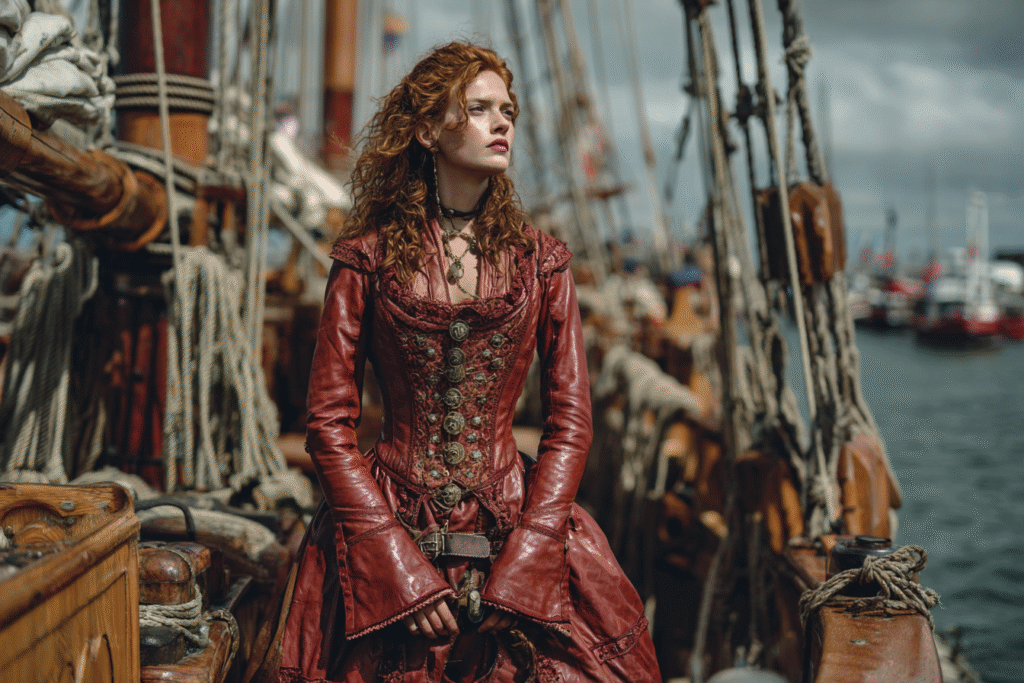
From SRP author Tracy Cooper-Posey:
Some women in history slip quietly between the pages. Others take a dagger to the margins and carve themselves a space. Grace O’Malley—known in Gaelic as Gráinne Mhaol—was absolutely the second kind.
She ruled the waves off the west coast of Ireland at a time when women were meant to embroider cushions, not command warships. She was born into a world that expected her to marry well, produce heirs, and fade dutifully into the background. Instead, she built a pirate empire, challenged a queen, and outlasted the men sent to break her.
A Queen of Clans, Not Courts
Grace was born around 1530 into the powerful O’Malley clan, lords of the sea who dominated trade and piracy along the Irish coast. When her father died, she didn’t wait for anyone to hand her a title. She claimed leadership of the clan, learned the intricate dance of alliances and betrayals, and became a political force in a world where women were often used as pawns—but rarely seen as players.
Twice married, she strategically leveraged both unions to amass ships, castles, and influence. One husband died (she kept the fleet), the other she divorced (she kept the castle). Somehow, she also kept his loyalty. Grace had a habit of rewriting the rules.
Of Babies and Blunderbusses
Her legend is as wild as the Atlantic she ruled. One story goes that just a day after giving birth on board her ship, she leapt up—bedraggled, bloodied, and furious—to repel a Turkish pirate attack with pistols in both hands. Honestly, I’ve had bad hair days that were more debilitating.
This is a woman who gave no quarter. At the height of her power, she commanded hundreds of men and dozens of ships, collecting “tolls” from any vessel daring to pass her stronghold at Clew Bay.
Crossing Swords With Elizabeth I
But if you think her biggest threat came from rival pirates or stormy seas, think again. Enter stage left: Queen Elizabeth I of England.
Two women. Two power centers. One very inconvenient ocean between them.
Elizabeth sought to tighten her grip on Ireland. Grace wasn’t having it. While English fleets clashed with O’Malley’s ships in guerrilla-style sea skirmishes, it was Governor Richard Bingham who truly brought the hammer down. He killed one of her sons, imprisoned another, and seized her lands and strongholds.
What did Grace do? She didn’t write angry letters or retreat into obscurity. She sailed straight into the lioness’s den.
The Pirate Queen Meets the Virgin Queen
In 1593, Grace requested an audience with Queen Elizabeth herself. The two women—both hardened leaders in their own right—met at Greenwich Palace. The details are gloriously murky: Grace supposedly refused to bow, possibly carried a dagger, and definitely refused Elizabeth’s offer of noble titles on the grounds that equals don’t confer titles on each other.
What’s not murky? She walked away with the release of her son, restoration of her lands, and a nod of reluctant respect from one of the most powerful monarchs in history.
Why Grace O’Malley Still Matters
Grace O’Malley wasn’t an anomaly. She was proof that women were always capable of power, strategy, leadership—and more importantly, the audacity to claim it.
She died in 1603, the same year as Elizabeth I. A fitting bookend for two women who defined their eras in very different ways.
History tends to file women like Grace under “colorful side characters” or “folk legend,” when really, she was the main event. She didn’t wait for history to hand her a role—she wrote herself into it, daggers drawn and sails high.

Tracy Cooper-Posey
SRP Author



